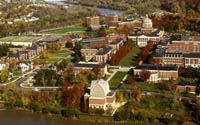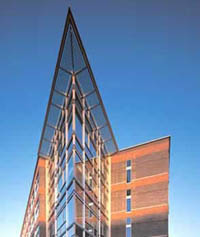History
 The first Dean of the Medical School, Nobel Laureate George Hoyt Whipple, M.D., came to Rochester in 1921 to put a revolutionary concept into practice. Whipple supervised the design, construction and staffing of the School of Medicine and Dentistry and Strong Memorial Hospital according to what was then a new framework advanced by medical-school pioneer Abraham Flexner. Whipple's vision, built on the philanthropy of George Eastman, was a school and a hospital under one roof that integrated basic science and clinical practice.
The first Dean of the Medical School, Nobel Laureate George Hoyt Whipple, M.D., came to Rochester in 1921 to put a revolutionary concept into practice. Whipple supervised the design, construction and staffing of the School of Medicine and Dentistry and Strong Memorial Hospital according to what was then a new framework advanced by medical-school pioneer Abraham Flexner. Whipple's vision, built on the philanthropy of George Eastman, was a school and a hospital under one roof that integrated basic science and clinical practice.
Today, that concept of physically integrating patient care and academics under one roof is still going strong. The main campus of the University of Rochester Medical Center covers over 4.4 million sq. feet of space. Strong Memorial Hospital covers 1.6 million sq. feet, the School of Medicine 2.1 million sq. feet, and the School of Nursing and the Eastman Dental Center about 100,000 sq. feet each.
Equally important, the integration of patient care and academics remains at the core of our School's philosophy and structure. Under the leadership of the Senior Vice President for Health Affairs, the Dean of the medical school and the President of our hospital system work in partnership on a daily basis with Department Chairs, Center Directors, the Dean of the School of Nursing, the Director of the Eastman Dental Center, and the financial and administrative leadership of the Medical Center. Working so closely together is how we successfully fulfill our interrelated missions of patient care, education, research, and community health.
The faculty of the School consists of approximately 1800 full-time faculty members and 1000 voluntary clinical faculty members organized into 32 Departments and Centers.
Clinical faculty members provide tertiary and quaternary services to the Upstate New York region and the Northeast, and also provide primary and specialty healthcare to our local population. They also train some 600 residents and fellows, who are drawn from all corners of the United States and beyond, to be the next generation of practitioners and academic leaders.

Research faculty have attracted external funding totaling approximately $200 million during the last fiscal year, divided evenly between basic and clinical research. Approximately $140 million was from the NIH and $60 million was from other federal agencies, from foundations and from industry. Our research portfolio has great depth and breadth. We have achieved top-15 rankings in NIH funding in biochemistry, microbiology and immunology, neurology, obstetrics and gynecology, oral biology, and musculoskeletal research.
In Education, we train some 500 graduate students to become the fundamental, translational and clinical investigators of the future, maintaining the critical link between scientific discovery and improved health. In undergraduate medical education, the concept of integrating cutting-edge, evidenced-based medical science and the relationship-centered art of clinical medical practice is embodied in our new "Double Helix Curriculum," which combines basic science and clinical work throughout all four years of medical school (like the strands of a Double Helix). This blend of the art and science of medicine also distinguishes our post-graduate medical education, where 500 residents and 100 fellows receive intensive, specialized training in virtually all medical specialties and subspecialties.
While there are a number of external forces that have caused some to become cynical about the future of biomedical science and practice, I believe that this is an extremely exciting time to be working at an academic health center. The prospects for the creation and dissemination of medical knowledge have never been greater, and the application of this knowledge to patient care through translational research will be rewarded in longer and healthier lives. The University of Rochester School of Medicine and Dentistry is proud to be in the thick of the excitement.